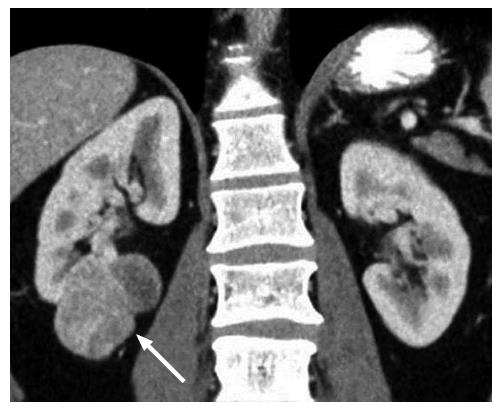Partial nephrectomy is a technically demanding operation using robotic surgery and intraoperative ultrasound to surgically remove the portion of the kidney that is suspicious for cancer with great precision. It is done to preserve as much normal kidney tissue as possible, yet to cure the kidney cancer. The urologic surgeons at Fore River Urology have world-class training and experience in kidney surgery to handle even the most challenging cases.

What is Robotic Assisted Laparoscopic DaVinci Surgery?
Robotic surgery is a type of minimally invasive surgery where a surgeon uses a robotic system to perform precise and controlled movements through small incisions. The robotic system consists of tiny instruments attached to robotic arms, which the surgeon controls from a console with a magnified 3D view of the surgical site. This technology allows for greater precision, flexibility, and smaller incisions, leading to less pain, reduced blood loss, quicker recovery, and minimal scarring compared to traditional open surgery. Robotic surgery is commonly used in procedures such as prostate, kidney, and reconstructive surgeries.
Surgical details:
Typically, this operation employs a laparoscopic technique, which allows for 4-6 tiny 8mm incisions rather than a large, more painful incision.

a. Kidney vessels with clamps on. Kidney is burgundy in the diagram with yellow overlying fat. b. Patient is positioned lying on their side with each black dot corresponding to an incision and port side.
The abdominal cavity is filled with carbon dioxide gas, and a camera and surgical instruments are passed through port sites in the abdominal wall. During the surgery, the blood vessels going into the kidney are temporarily clamped prior to the tumor being removed. The clamps are removed after the kidney is sewn back together. The DaVinci surgical robot is utilized by the surgeon to perform this operation, allowing for more precise movements, and enhanced visualization compared to traditional laparoscopic techniques. In rare circumstances, when it is felt that the operation cannot continue safely or efficiently in a laparoscopic manner, your surgeon may decide to convert to a traditional open technique, with a larger incision. In rare circumstances, your surgeon may ultimately need to remove the entire kidney.

This operation is performed in a hospital under general anesthesia, and requires a 1 night stay. Compared to total removal of the kidney, the cure rate for your cancer is equivalent, you ultimately save both kidneys, but there are increased short term complication risks.
What are the risks?
Benign pathology – In many cases, imaging tests are quite convincing and may estimate the probability of a kidney mass being ~80-85% likely. Often, you and your surgeon may forego a biopsy (which is common), and proceed directly to surgery. It is possible that after the surgery, it ultimately is discovered that the kidney was an uncommon benign variety. Often this comes as a relief to many patients.
Bleeding – As with any operation there will be some bleeding. Transfusion rates for this operation are typically less than 10%.
Infection – A preventative antibiotic is given prior to the surgery at the hospital, and overall infection rates are usually less than 5%. Most common sites of infection would be the skin where the surgical ports are placed, and are rapidly and effectively treated with antibiotics post-operatively.
Injury to nearby structures – There are numerous structures adjacent to the kidney that have risk of injury during this operation. Such risk is very low, but can include injuries to the spleen, pancreas, adrenal gland, colon, small intestine, or liver.
Urine leak / urinoma – If there area where the kidney was repaired has difficulty healing, it could sprout a leak from the urinary portion of the kidney after the first few days to weeks after surgery. In order to manage this situation, a drain (small tube) may need to be placed into the area to pull any excess fluid/urine out of the body. In some cases, a drain may be used for a longer duration, and sometimes an internal ureteral stent would be placed to better facilitate healing.
Cancer recurrence – In the affected kidney or elsewhere in the body, cancer can recur. Given the nature of this operation, there is a chance a cancer is incompletely resected, with recurrence rates overall of approximately 5%. In this setting, the patient may require additional treatments in the future.
Renal dysfunction – Depending on your baseline overall renal function, which often relates to other medical conditions (such as diabetes or hypertension), this surgery can result in the worsening of your kidney function. While this surgery is done to preserve as much normal kidney tissue as possible, the need for dialysis, temporary or permanent, is a risk. This can be individually assessed by your surgeon, and general the risk is low.
Conversion to radical nephrectomy – Finally, while the goal of this operation is to leave as much of the remaining kidney intact, it is possible your surgeon may decide intraoperatively to remove the entire kidney.
Anesthetic and other risks – Significant events such as heart attack, stroke, even death may occur as a result of any anesthetic, though such risks are extraordinarily low, especially if properly evaluated by your primary physician before surgery if indicated. Should you develop any pain or swelling of your lower legs and ankles following surgery, notify your doctor’s office immediately, as this may indicate a blood clot in your leg (deep vein thrombosis or “DVT”). If a blood clot moves to the lung this could be immediately life-threatening, and usually presents with shortness of breath and/or painful breathing.
How soon do we need to take action?
This depends on the size and level of concern of the kidney mass. However, as the patient you should feel reassured that this is rarely an emergency. Kidney cancers grow relatively slowly, and making the right decision with the right team is more important than rushing in. Consult with your surgeon about appropriate timing.
What are preparations for surgery?
Please have nothing to eat or drink after midnight prior to your surgery. If you take blood thinners, your surgeon will have discussed stopping this medication prior to your surgery. Additionally, you will often meet with a hospitalist physician who will be part of the care team during your hospital stay. They are critical in helping to manage complex non-surgical conditions and medical conditions that may arise or be discovered during your hospitalization.
Recovery:
In Hospital
You will stay in the hospital for observation overnight. There is typically a bladder catheter in place. This tube is usually removed the next day. 95%+ of patients will go home the day after surgery (typically late morning), but we will make sure that you are safe to do so by checking some routine lab work, ensuring that you can walk and that your pain is sufficiently managed prior to leaving the hospital. In the days following surgery, it is normal to feel some discomfort in the incision sites and the abdomen.
Pain Control
50% of patients are able to leave the hospital without needing narcotic pain medicine. At most, patient’s may need light narcotics for a few days after surgery. If so, they need to take stool softeners to ensure they do not get constipated.
It’s very normal to feel shoulder pain 3-6 days after surgery, this is from the laparoscopic gas. Some blood in the urine is normal.
Timeline for Recovery
Patients are typically fatigued and sore for about 1 week after surgery. You will be able to walk normally, climb stairs, and care for yourself quite normally. By the 2 week mark, most patients feel almost completely normal.
Restrictions
No lifting/twisting/pushing/torquing/exerting beyond 15 lbs of force for 1 month after surgery unless otherwise specified by your surgeon.
Bathing
No baths or freshwater swimming for 2 weeks. Showering is ok almost immediately, do not scrub the incisions or apply any product to them. Let them heal on their own. Let the water run over and pat them dry.
Resuming activities
You can go back to work when you feel able, usually within one to two weeks, but this of course depends on the nature of your work. Typically, we ask that you abstain from any heavy physical activity for four to six weeks. You may drive when you feel able and are not under the influence of any medications.
Follow-up
Your doctor will arrange a follow-up visit, usually two weeks following surgery, to ensure you are progressing appropriately, and to review the pathologic findings of your tumor. For any concerns, do not hesitate to call our office for advice or instruction.
Who performs this operation?
Our practice has three highly experienced and world-class trained surgeons in robotic kidney surgery.



